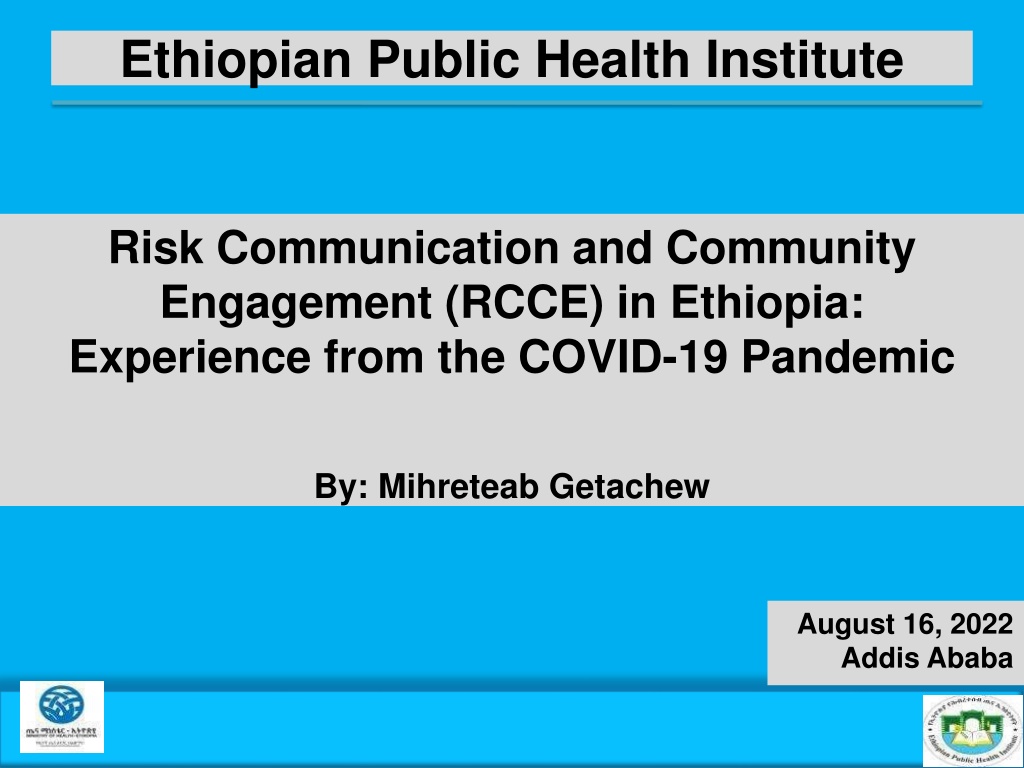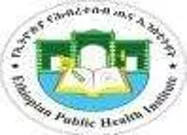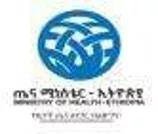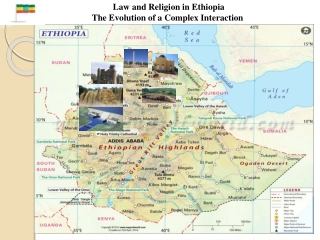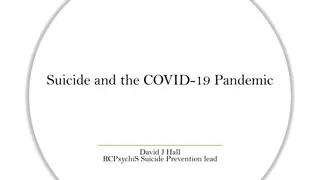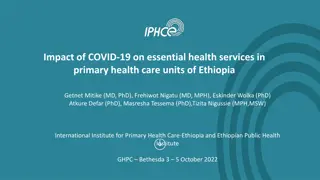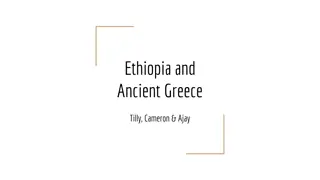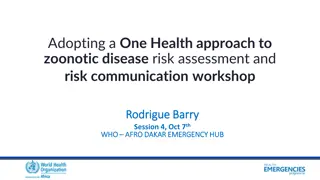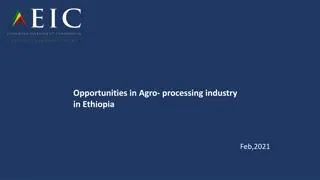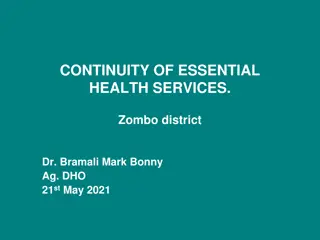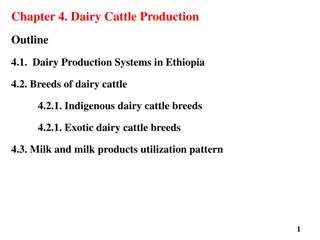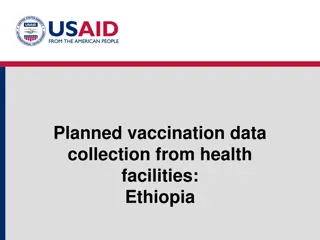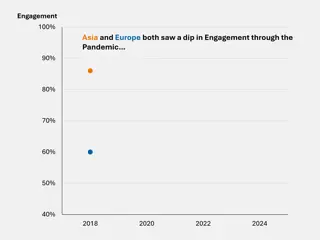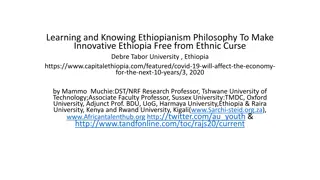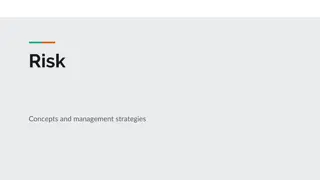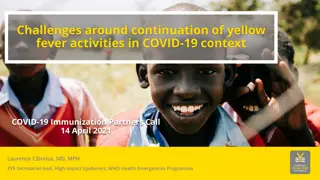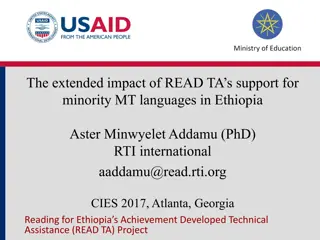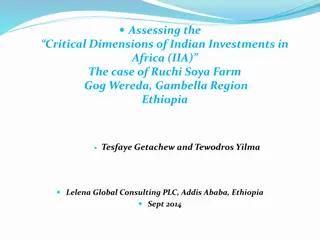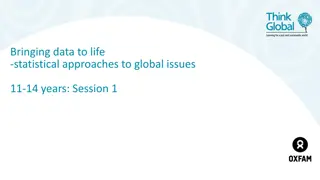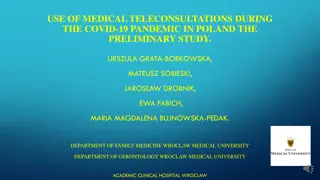Risk Communication and Community Engagement in Ethiopia during COVID-19 Pandemic
The Ethiopian Public Health Institute implemented a Risk Communication and Community Engagement strategy during the COVID-19 pandemic to provide real-time information and guidance to the public. The presentation outlines the background, challenges faced, and key principles such as trust, transparency, and proactive communication. The integrated model for risk communication emphasized addressing uncertainty and dynamic listening to effectively engage with affected communities. Various teams and stakeholders were involved in the strategic response, with a focus on preparedness, response activities, and operational research.
Download Presentation

Please find below an Image/Link to download the presentation.
The content on the website is provided AS IS for your information and personal use only. It may not be sold, licensed, or shared on other websites without obtaining consent from the author. Download presentation by click this link. If you encounter any issues during the download, it is possible that the publisher has removed the file from their server.
E N D
Presentation Transcript
Ethiopian Public Health Institute Risk Communication and Community Engagement (RCCE) in Ethiopia: Experience from the COVID-19 Pandemic By: Mihreteab Getachew August 16, 2022 Addis Ababa
Presentation outline Background Risk Communications Systems Internal &partner communication and coordination Public Communication Engaging with Affected community Dynamic Listening and Rumor Management Challenges Encountered and Recommendations
Background RC Definition: refers the real-time exchange of information, advice and opinions between experts or officials and people who face a threat (hazard) to their survival, health, economic, social well-being. Better Decisions /Actions Increases Trust Reduces anxiety Purpose: its purpose is to help everyone at risk to take informed decisions to mitigate the effects of the threat (hazard) such as COVID-19 and take protective and preventive action. 3
Back Integrated model for risk communication 8/5/2024 4
Back Principles 1. Trust 2. Addressing Uncertainty 3. Coordination 4. Transparency and Speed 5. Proactive communication 6. Involvement and engagement 7. Integration of approaches 8. Strengthening national capacity
Back COVID-19 was declared Public Health Emergency of International Concern (PHEIC) on January 30th, 2020. COVID-19 was declared as a pandemic on March 11th, 2020 by WHO. Preparedness and response activities for COVID-19 in Ethiopia began by activating Public Health Emergency Operations Center (PHEOC) in January, 2020. PHEOCs are operated by an Incident Management System (IMS) wich have different functional pillar Risk communication and community engagement is one of the functional pillars of the IMS.
IMS Dr Lia Tadese Minister, Ministry of Health COVID-19 Task Force Dr Tsigereda Kifle Director General, EPHI Strategic Level Aschalew Abayneh DDG/EPHI-Incident Manager Dr Mikiyas Teferi Deputy Incident Manager From EPHI From MOH Dr. Woldesenbet Wogeno Dr Wondwosen Eshetu Clinical Advisory Team Partnership/Liaison Public Information Dr. Feyisa Gezagn Tesfaye Dr. Dereje Abiy Multisectoral Engagement Team (5) Alemayehu Birahanu Berehanu Tadesse Private Engagement and regulatory (3) Emergency and COVID 19 logistics and supplies Team ( 8) Operational Research General Services Adugna Abera Epi- Surveillence & Lab Section Daniel Melese Regional support & RCCE Section Dr Mikiyas Teferi Case management, Facility Readiness, IPC/WaSH Section Mengistu Temesgen Dr Ahmed Mohammed Admin. Section Planning Section Alert & Rumor Mgt: RRT and Contact tracing Facility Readiness and Clinical Management Human Resources Mgt Training Unit RCCEC: Content devt & Graphic Design, production,Media Monitoring and Community Engagement Laboratorys and seqaunceing Epidemiological and lab Data Management Home Based Isolation Care and MPHSS Documentation Unit Transport REGIONAL Support IPC and WaSH Office Management Finance and procurement Situation Update Unit PoE Logistics Plan M & E Unit
Back Overall objective Empower individuals, families, and communities to adopt preventive, vaccine acceptance and health seeking behaviours contributing to COVID-19 Outbreak prevention and control in Ethiopia. Specific objectives 1.Facilitate community-led responses 2.Strengthen media engagement and relations 3.Generate, analyze and use evidence 4.Building capacity of health professional and community health workers 5.Improve COVID-19 vaccine acceptance 6.Ensure effective integration of COVID-19 RCCE intervention
Risk communication systems TOR, SOP developed Strategy developed/revised 2 times Regional EOC s established including RCCE pillar Developed plan for three scenarios Developed Training package for stakeholders and partners such as CCRDA to use Established RCCE TWG Established Advisory groups Trained all regional EOC including RCCE teams, case management teams, surveillance teams Mobilized voluntary production houses for developing messages and partners to assign experts. Hired TA s, toll free line responders and graphic designers in all regions Televised trainings integrated
systems RCCE team former structure Had 18 staff, but changed over time RCCE Coordinator (coordination & partnership) Technical coordinator Planning Monitoring & Evaluation (quality assurance and timeliness) Community engagemen t Budget & Finance and logistics for distribution of materials Monitoring and follow up of activities Training team: capacity building content and material development Public Communication Community feedback & KAP(hot line) psychosoci al support Media monitoring and rumor management Press Graphic designing & Printing Community mobilization/ empowerment Content developer conference/ release Media Engagement
systems RCCE team current structure Has 5 members RS&RCCE Content Development and Production Media Regional Support Community Engagement Engagement and Monitoring
Internal and external com. Daily meetings with national EOC Weekly meetings with regional RCCE team Feedback from tollfree and media monitoring shared to responsible teams Mobilized and engaged Partners in RCCE, coordination meetings held at national and regional level Continuous communication with religious organization using Inter Religious Council of Ethiopia Created Telegram group with sector PR for sharing of information Health professional associations were engaged as advisory groups Frequent meetings with media house owners with PM press secretariat and sectoral PR houses
Public communication Identified target audiences based on the phase of the emergency Mapped public communication channels TV, Radio, Community Radio, street screens, news papers, mini medias with relevant contact persons Identified influential individuals such as media house owners, journalists, artists, social media influencers Conducted Advocacy and Capacity building trainings for these individuals Identified spokes persons from each discipline to conduct media sessions Conducted regular Press conference once in two weeks, weekly and based on need Conducted regular interviews, panel discussion, appearance on news on almost all media outlets Developed Branding guide, Message guide, SOP for public communication, Pocket guide for spokes persons
Public communication Developed information packs/kits for media personnel, artists, Gov. PR Facebook, Telegram and Website content regularly updated WhatsApp and telegram boats developed and launched Information card/business card in Amharic, chines and English with QR code developed distributed at bole airport Video and audio message in Amharic and English developed distributed at bole airport Used CRBT, IVR and SMS in collaboration with Ethiotel to disseminate Messages Disseminate different COVID-19 messages in print, audio and video format for different target audiences and on different issues
Engaging with affected Community Developed varies guides/message kits to facilitated community engagement activities: Community disclosure guide, Community engagement guide, 72 hours containment strategy, Complete lockdown guide, multisectoral engagement, religious leaders, school, HEWs guide, WDA guide, volunteer guide, refugee guide, nursing home guide, prison guide, hotels/restaurants/guest houses guide, transport corridors guide, community conversation guide, peer education guide, Developed and amended three Directives 30/803/882 During the initial phase training/orientations provided for high risk populations; airport staff, hotel managers/owners, tour operators, airport taxi drivers, hotel shuttles, industry park, land port workers, health facility managers, construction workers Mobilized huge number of volunteers in collaboration with sector organizations to conduct community engagement activities at community level, crowded places such as transport hubs, market areas and religious institutes.
Engaging with Provided trainings to health professionals using IVR and application. Conducted Advocacy on health professional associations, parliamentarians to mobilize support for the response Mobilized partners for Procurement and distribution of megaphones to supported social mobilization activities using mobile vans in high risk sites Developed School reopening guide and provided training Supported the development of the risk communication and risk management guide developed, and provided training for health care workers in conflict affected areas. Developed a Package for safe election and provided training
Engaging with Conducted advocacy meetings for the enforcement of COVID-19 directives Organized consultative meeting with community influencers, religious leaders, political leaders, police, medias and partners on COVID-19 preventive measures during the celebration of religious, public holidays and national events Integration guide and implementation manual developed, Training for integration provided and App on the guide developed. Developed guide with religious leaders on covid and vaccine Organized and implemented four campaigns; COMBAT, Mask Ethiopia, No Mask No service, Dagim Tikuret
Dynamic listening and rumor mgt. Established Tollfree lines in all region Electronic tollfree responders communication guide which which are centrally updated developed and installed Used different methods to generate evidence and monitor community feedback UNICEF talkwalker, media monitoring, toll free logs, Social media poll, Google form assessments, facility based assessments, KAP assessments, barrier analysis Rumor logs and reporting format for HEWs developed House to house monitoring Used evidences generated by other institutions such as universities Based on findings provided response in social media Live streaming, news, press release/conference, articles, FAQs Provided Continuous training for 8335/952 responders on new development and burnout management
Challenges Shortage of manpower on RCCE at regional level. Poor RCCE capacity at lower level of the health system No graphic designer and studio at the national EOC Lengthy and restrictive procurement process Traditional monitoring and community feedback collection mechanism Inability to disseminate messages by the right channel due to procurement processes Using non credible sources of information by media. Toll free lines currently being shut down in most regions Poor evidence generation and use at lower level
